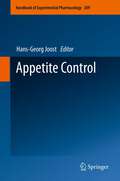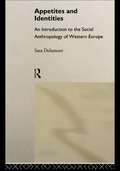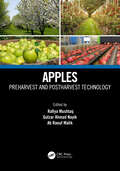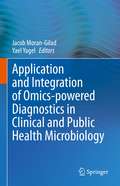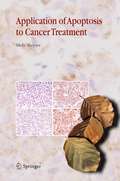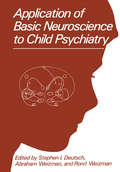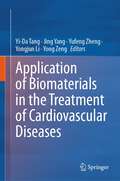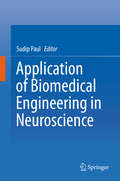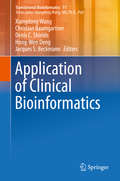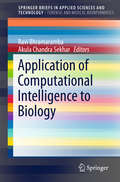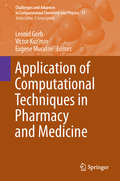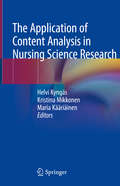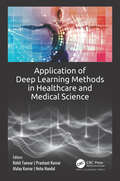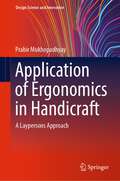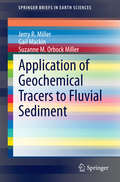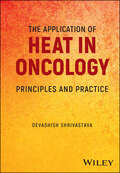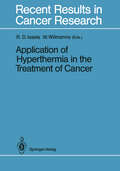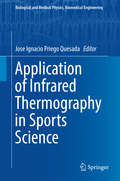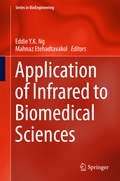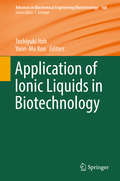- Table View
- List View
Appetite and Its Discontents: Science, Medicine, and the Urge to Eat, 1750-1950
by Elizabeth A. WilliamsWhy do we eat? Is it instinct? Despite the necessity of food, anxieties about what and how to eat are widespread and persistent. In Appetite and Its Discontents, Elizabeth A. Williams explores contemporary worries about eating through the lens of science and medicine to show us how appetite—once a matter of personal inclination—became an object of science. Williams charts the history of inquiry into appetite between 1750 and 1950, as scientific and medical concepts of appetite shifted alongside developments in physiology, natural history, psychology, and ethology. She shows how, in the eighteenth century, trust in appetite was undermined when researchers who investigated ingestion and digestion began claiming that science alone could say which ways of eating were healthy and which were not. She goes on to trace nineteenth- and twentieth-century conflicts over the nature of appetite between mechanists and vitalists, experimentalists and bedside physicians, and localists and holists, illuminating struggles that have never been resolved. By exploring the core disciplines in investigations in appetite and eating, Williams reframes the way we think about food, nutrition, and the nature of health itself..
Appetite Control (Handbook of Experimental Pharmacology #209)
by Hans-Georg JoostThe volume ‘Appetite Control’ provides a comprehensive description of the mechanisms controlling food intake, and thereby energy balance, in the mammalian organism. During the last decade, research in this area has produced a remarkable wealth of information and has characterized the function of numerous peptides, transmitters, and receptors in appetite control. Dysfunction of these circuits leads to obesity, a growing health concern. However, the plethora of mechanistic information is in marked contrasts to an almost complete lack of anti-obesity drugs that meet the safety standards required for the chronic therapy of morbid obesity. Consequently, ongoing research aims to identify additional targets and agents for a pharmacological intervention. Thus, the mechanisms of appetite control as well as all agents interfering with its control are of considerable practical interest.The authors of the volume are distinguished scientists who are leading experts in the field, and who have contributed important, original data to our understanding of the mechanisms of appetite control. They have quite different scientific backgrounds and, together, they represent all relevant disciplines. Thereby, the topics are presented from different points of view, not exclusively from that of pharmacology and neuroendocrinology. Thus, the volume addresses all scientists who are interested in the field of obesity research and the pathophysiology of appetite control.
Appetites and Identities: An Introduction to the Social Anthropology of Western Europe
by Sara DelamontAppetites and Identities is a clear, inviting and fascinating introduction to the social anthropology of western Europe. It covers food, migration, politics, urban and country life, magic, religion, sex and language in an accessible and straightforward fashion, introducing the student to aspects of the anthropology of contemporary European culture from mussel farmers in the Netherlands to Basque chambermaids in Lourdes, and from unhappy bachelors in western Ireland to unwitchers in Portugal.Avoiding the technical language of many anthropological textbooks, Appetites and Identities sets out the anthropological literature on the rich diversity of dialects, cultures and everyday lives of western European people, offering fascinating insights on how each region and community differs from its counterparts despite the notion of an integrated Europe. The book will stimulate curiosity about social anthropological investigation, and about life in Europe today.
Appetites and Identities: An Introduction to the Social Anthropology of Western Europe
by Sara DelamontAppetites and Identities is a clear, inviting and fascinating introduction to the social anthropology of western Europe. It covers food, migration, politics, urban and country life, magic, religion, sex and language in an accessible and straightforward fashion, introducing the student to aspects of the anthropology of contemporary European culture from mussel farmers in the Netherlands to Basque chambermaids in Lourdes, and from unhappy bachelors in western Ireland to unwitchers in Portugal.Avoiding the technical language of many anthropological textbooks, Appetites and Identities sets out the anthropological literature on the rich diversity of dialects, cultures and everyday lives of western European people, offering fascinating insights on how each region and community differs from its counterparts despite the notion of an integrated Europe. The book will stimulate curiosity about social anthropological investigation, and about life in Europe today.
Apples: Preharvest and Postharvest Technology
by Rafiya Mushtaq Gulzar Ahmad Nayik Ab Raouf MalikDue to polymorphism, apples have extraordinary diversity. Depending on variety, apple fruits can differ in color, shade or size; apples even can be oval or pear-shaped. There are more than 10,000 varieties of apple, which vary in taste, shape, juiciness, texture, color, firmness and other qualities. For these reasons, apples have been diversely studied, and many improvements have been made such as the introduction of high density cropping; rootstock breeding; or varietal development. Therefore it is important to understand and document the production methods adopted and implemented in recent times for harvesting maximum benefits of the crop. Apples: Preharvest and Postharvest Technology documents production practices along with detailed illustration on varieties, rootstocks, important cultural practices and post-harvest management. This book will serve as a complete guide for apple production from farm to fork and will help students, scholars, researchers and scientists working in this domain. The book will also help growers all over the world to understand best practices for apple production, to harvest maximum yields, and in turn, to increase their returns.
Apples: Preharvest and Postharvest Technology
by Rafiya Mushtaq Gulzar Ahmad Nayik Ab Raouf MalikDue to polymorphism, apples have extraordinary diversity. Depending on variety, apple fruits can differ in color, shade or size; apples even can be oval or pear-shaped. There are more than 10,000 varieties of apple, which vary in taste, shape, juiciness, texture, color, firmness and other qualities. For these reasons, apples have been diversely studied, and many improvements have been made such as the introduction of high density cropping; rootstock breeding; or varietal development. Therefore it is important to understand and document the production methods adopted and implemented in recent times for harvesting maximum benefits of the crop. Apples: Preharvest and Postharvest Technology documents production practices along with detailed illustration on varieties, rootstocks, important cultural practices and post-harvest management. This book will serve as a complete guide for apple production from farm to fork and will help students, scholars, researchers and scientists working in this domain. The book will also help growers all over the world to understand best practices for apple production, to harvest maximum yields, and in turn, to increase their returns.
Application and Integration of Omics-powered Diagnostics in Clinical and Public Health Microbiology
by Jacob Moran-Gilad Yael YagelVarious “omics” methods have recently revolutionized molecular diagnostics. Next-generation sequencing (NGS) makes it possible to sequence a human genome in just one day. Whole genome sequencing (WGS) greatly improves the ability to investigate the outbreaks of numerous pathogens. Metagenomics helps to analyze the microbiome, which aids greatly in identifying the pathogenesis of infectious diseases. Proteomic-based methods, namely matrix-assisted laser desorption-ionization time of flight mass spectrometry (MALDI-TOF-MS), have a promising role in identifying myctobacteria and fungi, and predicting antimicrobial resistance. While there are numerous scientific publications on “omics” applications for microbiology, there are relatively few books that review this topic from a clinical diagnostics perspective. This book looks at this field from a holistic viewpoint, instead of limiting by type of “omics” technology, in order to cover the body of knowledge needed for practitioners and academics interested in clinical and public health microbiology. Additionally, it addresses the management, economical, regulatory and operational aspects of integrating these technologies into routine diagnostics.
Application of Apoptosis to Cancer Treatment
by Mels SluyserNovel drugs are being developed which interact with the programmed cell death (apoptotic) machinery in cancer cells, thereby causing these cells to commit suicide and to be removed from the body. Research is also directed to investigate why the cancer cells sometimes lose the ability to undergo apoptosis after a certain period of time and methods are being developed to reactivate this cell death process. This book is intended for workers in the field and clinicians as a useful guide of the state of affairs in this exciting field which may offer more effective possibilities for treatment of cancer patients. Mels Sluyser is the Editor of the journals APOPTOSIS and ANTI-CANCER DRUGS. He brings together a collection of papers written by the world’s leading experts in these fields.
Application of Basic Neuroscience to Child Psychiatry
by Stephen I. Deutsch, Abraham Weizman and Ronit WeizmanThe idea for this book developed during the course of several discussions among the editors while we were working together as staff scientists in the laboratories of the Clinical Neuro science Branch of the National Institute of Mental Health. It was a happy coincidence that the three of us, child psychiatrists with predominantly clinical interests, selected a collaborative bench research project involving neurotransmitter receptor characterization and regulation. We appreciated the relevance of our work to child psychiatry and wished for a forum to share the excitement we enjoyed in the laboratory with our clinical colleagues. Moreover, it seemed to us that much of the pharmacological research in child psychiatry proceeded on an empirical basis, often without a compelling neurochemical rationale. This could reflect the paucity of neurochemical data that exists in child psychiatry and the very limited understanding of the pathophysiology in most psychiatric disorders that occur in childhood. Also, we bemoaned the fact that there was a virtual absence of meaningful interchange between clinical investigators in child psychiatry and their colleagues in the neurosciences. We believed that an edited book appealing to clinicians and basic scientists could serve as an initial effort to foster interchange between them. The editors wish to emphasize that this book is viewed as only a beginning in the process of interchange that must take place.
Application of Biomaterials in the Treatment of Cardiovascular Diseases
by Yi-Da Tang Jing Yang Yufeng Zheng Yongjun Li Yong ZengThis book summarizes the recent advancements for biomaterials in the field of cardiovascular disease, including drug delivery system (gene, protein, drug), implant interventional instrument (heart valve, heart blocker, stent, artificial blood vessel, patch, artificial heart, cardiac pacemaker, etc.) have been innovated and applied to the clinical uses to treatment of cardiovascular disease. Through the summary of this book, readers will have comprehensive and advanced understanding of the application of biomaterials in the field of cardiovascular disease.
Application of Biomedical Engineering in Neuroscience
by Sudip PaulThis book focuses on interdisciplinary research in the field of biomedical engineering and neuroscience. Biomedical engineering is a vast field, ranging from bioengineering to brain-computer interfaces. The book explores the system-level function and dysfunction of the nervous system from scientific and engineering perspectives. The initial sections introduce readers to the physiology of the brain, and to the biomedical tools needed for diagnostics and effective therapies for various neurodegenerative and regenerative disorders. In turn, the book summarizes the biomedical interventions that are used to understand the neural mechanisms underlying empathy disorders, and reviews recent advances in biomedical engineering for rehabilitation in connection with neurodevelopmental disorders and brain injuries. Lastly, the book discusses innovations in machine learning and artificial intelligence for computer-aided disease diagnosis and treatment, as well as applications of nanotechnology in therapeutic neurology.
Application of Clinical Bioinformatics (Translational Bioinformatics #11)
by Xiangdong Wang Christian Baumgartner Denis C. Shields Hong-Wen Deng Jacques S. BeckmannThis book elucidates how genetic, biological and medical information can be applied to the development of personalized healthcare, medication and therapies. Focusing on aspects of the development of evidence-based approaches in bioinformatics and computational medicine, including data integration, methodologies, tools and models for clinical and translational medicine, it offers an essential introduction to clinical bioinformatics for clinical researchers and physicians, medical students and teachers, and scientists working with human disease-based omics and bioinformatics. Dr. Xiangdong Wang is a distinguished Professor of Medicine. He is Director of Shanghai Institute of Clinical Bioinformatics, Director of Fudan University Center for Clinical Bioinformatics, Deputy Director of Shanghai Respiratory Research Institute, Director of Biomedical Research Center, Fudan University Zhongshan Hospital, Shanghai, China; Dr. Christian Baumgartner is a Professor of Health Care and Biomedical Engineering at Institute of Health Care Engineering with European Notified Body of Medical Devices, Graz University of Technology, Graz, Austria; Dr. Denis Shields is a Professor of Clinical Bioinformatics at Conway Institute, Belfield, Dublin, Ireland; Dr. Hong-Wen Deng is a Professor at Department of Biostatistics and Bioinformatics, Tulane University School of Public Health and Tropical Medicine, USA; Dr. Jacques S Beckmann is a Professor and Director of Section of Clinical Bioinformatics, Swiss Institute of Bioinformatics, Switzerland.
Application of Computational Intelligence to Biology (SpringerBriefs in Applied Sciences and Technology)
by Ravi Bhramaramba Akula Chandra SekharThis book is a contribution of translational and allied research to the proceedings of the International Conference on Computational Intelligence and Soft Computing. It explains how various computational intelligence techniques can be applied to investigate various biological problems. It is a good read for Research Scholars, Engineers, Medical Doctors and Bioinformatics researchers.
Application of Computational Techniques in Pharmacy and Medicine (Challenges and Advances in Computational Chemistry and Physics #17)
by Leonid Gorb Victor Kuz’min Eugene MuratovThe proposed volume provides both fundamental and detailed information about the computational and computational-experimental studies which improve our knowledge of how leaving matter functions, the different properties of drugs (including the calculation and the design of new ones), and the creation of completely new ways of treating numerical diseases. Whenever it is possible, the interplay between theory and experiment is provided. The book features computational techniques such as quantum-chemical and molecular dynamic approaches and quantitative structure–activity relationships.The initial chapters describe the state-of-the art research on the computational investigations in molecular biology, molecular pharmacy, and molecular medicine performed with the use of pure quantum-chemical techniques. The central part of the book illustrates the status of computational techniques that utilize hybrid, so called QM/MM approximations as well as the results of the QSAR studies which now are the most popular in predicting drugs’ efficiency. The last chapters describe combined computational and experimental investigations.
The Application of Content Analysis in Nursing Science Research
by Helvi Kyngäs Kristina Mikkonen Maria KääriäinenThis book provides principles on content analysis and its application into development of nursing theory. It offers clear guidance to students, lecturers and researchers to gain a deeper understanding of the method of content analysis, its implementation into their own research and criteria of trustworthiness evaluation. The book is written in user-friendly language with provided research examples and cases, and the content is illustrated by figures and tables. The authors offer their expertise in providing a well thought through explanation of content analysis in didactical style, which will enhance university education. The book includes highly experienced researchers who have published articles on content analysis and the trustworthiness of the method with more than 10 000 citations. Divided into two parts, this book explores the application of content analysis into nursing science. The first part presents the philosophical position of content analysis, inductive and deductive methods of using content analysis, trustworthiness of the method, and ethical consideration of using content analysis. The second part informs on the theory development based on content analysis, conceptualization of the concepts of content analysis into generation of items and instrument development, and statistical testing of a hypothetical model. The last chapter shows a new approach to using content analysis in systematic reviews and quality evaluation of methodology within systematic review process. The book is an essential tool for nursing science, providing instruction on key methodological elements in order to provide rigorously conducted empirical research for clinical practice and nursing education.
Application of Deep Learning Methods in Healthcare and Medical Science
by Rohit Tanwar Prashant Kumar Malay Kumar Neha NandalThe volume provides a wealth of up-to-date information on developments and applications of deep learning in healthcare and medicine, providing deep insight and understanding of novel applications that address the tough questions of disease diagnosis, prevention, and immunization. The volume looks at applications of deep learning for major medical challenges such as cancer detection and identification, birth asphyxia among neonates, kidney abnormalities, white blood cell segmentation, diabetic retinopathy detection, and Covid-19 diagnosis, prevention, and immunization. The volume discusses applications of deep learning in detection, diagnosis, intensive examination and evaluation, genomic sequencing, convolutional neural networks for image recognition and processing, and more for health issues such as kidney problems, brain tumors, lung damage, and breast cancer. The authors look at ML for brain tumor segmentation, in lung CT scans, in digital X-ray devices, and for logistic and transport systems for effective delivery of healthcare.
Application of Deep Learning Methods in Healthcare and Medical Science
by Rohit Tanwar Prashant Kumar Malay Kumar Neha NandalThe volume provides a wealth of up-to-date information on developments and applications of deep learning in healthcare and medicine, providing deep insight and understanding of novel applications that address the tough questions of disease diagnosis, prevention, and immunization. The volume looks at applications of deep learning for major medical challenges such as cancer detection and identification, birth asphyxia among neonates, kidney abnormalities, white blood cell segmentation, diabetic retinopathy detection, and Covid-19 diagnosis, prevention, and immunization. The volume discusses applications of deep learning in detection, diagnosis, intensive examination and evaluation, genomic sequencing, convolutional neural networks for image recognition and processing, and more for health issues such as kidney problems, brain tumors, lung damage, and breast cancer. The authors look at ML for brain tumor segmentation, in lung CT scans, in digital X-ray devices, and for logistic and transport systems for effective delivery of healthcare.
Application of Ergonomics in Handicraft: A Laypersons Approach (Design Science and Innovation)
by Prabir MukhopadhyayThis book is about the application of ergonomics in handicraft manufacturing and design keeping in mind the two sets of users, craftsmen and customers buying handicraft items. Written in an easy to understand language and in a story telling format. It requires no prior knowledge of the subject nor any knowledge of science or technology for using this book and applying it in handicraft manufacturing and design. The book starts with an overview of the application of ergonomics in different aspects of craft manufacturing, touching upon tools, space, process and then moves into the aspects of ergonomics of craft packaging and displaying. Alongside the book also explains the ergonomic aspects of designing of handicraft products keeping the users of the products in mind, their dimensions, capacity, limitations etc. Each chapter starts with an "overview" and ends with "key points" and exercises to help the readers in applying the principles of ergonomics in handicraft. The last chapter is dedicated to exercises in different areas of handicraft and the ergonomic applications for them, followed by ergonomic design directions to solve them.
Application of Geochemical Tracers to Fluvial Sediment (SpringerBriefs in Earth Sciences)
by Jerry R. Miller Gail Mackin Suzanne M. Orbock MillerThis book takes an in-depth look at the theory and methods inherent in the tracing of riverine sediments. Examined tracers include multi-elemental concentration data, fallout radionuclides (e.g., 210Pb, 137Cs, 7Be), radiogenic isotopes (particularly those of Pb, Sr, and Nd), and novel (“non-traditional”) stable isotopes (e.g., Cd, Cu, Hg, and Zn), the latter of which owe their application to recent advances in analytical chemistry. The intended goal is not to replace more ‘traditional’ analyses of the riverine sediment system, but to show how tracer/fingerprinting studies can be used to gain insights into system functions that would not otherwise be possible. The text, then, provides researchers and catchment managers with a summary of the strengths and limitations of the examined techniques in terms of their temporal and spatial resolution, data requirements, and the uncertainties in the generated results. The use of environmental tracers has increased significantly during the past decade because it has become clear that documentation of sediment and sediment-associated contaminant provenance and dispersal is essential to mitigate their potentially harmful effects on aquatic ecosystems. Moreover, the use of monitoring programs to determine the source of sediments to a water body has proven to be a costly, labor intensive, long-term process with a spatial resolution that is limited by the number of monitoring sites that can be effectively maintained. Alternative approaches, including the identification and analysis of eroded upland areas and the use of distributed modeling routines also have proven problematic. The application of tracers within riverine environments has evolved such that they focus on sediments from two general sources: upland areas and specific, localized, anthropogenic point sources. Of particular importance to the former is the development of geochemical fingerprinting methods that quantify sediment provenance (and to a much lesser degree, sediment-associated contaminants) at the catchment scale. These methods have largely developed independently of the use of tracers to document the source and dispersal pathways of contaminated particles from point-sources of anthropogenic pollution at the reach- to river corridor-scale. Future studies are likely to begin merging the strengths of both approaches while relying on multiple tracer types to address management and regulatory issues, particularly within the context of the rapidly developing field of environmental forensics.
The Application of Heat in Oncology: Principles and Practice
by Devashish ShrivastavaTHE APPLICATION OF HEAT IN ONCOLOGY Understand the use of heat to destroy tumors with this comprehensive guide Heat is an indispensable resource in the destruction of cancerous tumors to potentially treat cancers. There are also real challenges, however, involved in the total destruction of tumors without destroying healthy tissue surrounding the tumor in the process. A detailed understanding of the propagation of thermal energy, induced heating, and tissue responses to heat is required to safely and successfully apply heat-based technologies in clinical oncology. The Application of Heat in Oncology supplies this understanding, with a thorough, comprehensive overview of the principle and practice involved. Offering both a detailed introduction to the physics and thermodynamics of induced heat and an analysis of its clinical applications, this is an essential resource for clinicians, technicians, and others in oncological practice. The Application of Heat in Oncology readers will also find: Guidelines for applying heat both safely and effectively Detailed discussion of topics including energy delivery (e.g., via RF, MW, ultrasound, laser, cryoagents, hyperthermia, nanoparticles, etc.), temperature assessment, damage assessment, image guidance, and more Summary of current practice along with suggestions for future areas of technological improvement The Application of Heat in Oncology is ideal for all clinicians working in the field of cancer treatment, including medical students, residents, researchers, engineers, radiologists, surgeons, and more.
The Application of Heat in Oncology: Principles and Practice
by Devashish ShrivastavaTHE APPLICATION OF HEAT IN ONCOLOGY Understand the use of heat to destroy tumors with this comprehensive guide Heat is an indispensable resource in the destruction of cancerous tumors to potentially treat cancers. There are also real challenges, however, involved in the total destruction of tumors without destroying healthy tissue surrounding the tumor in the process. A detailed understanding of the propagation of thermal energy, induced heating, and tissue responses to heat is required to safely and successfully apply heat-based technologies in clinical oncology. The Application of Heat in Oncology supplies this understanding, with a thorough, comprehensive overview of the principle and practice involved. Offering both a detailed introduction to the physics and thermodynamics of induced heat and an analysis of its clinical applications, this is an essential resource for clinicians, technicians, and others in oncological practice. The Application of Heat in Oncology readers will also find: Guidelines for applying heat both safely and effectively Detailed discussion of topics including energy delivery (e.g., via RF, MW, ultrasound, laser, cryoagents, hyperthermia, nanoparticles, etc.), temperature assessment, damage assessment, image guidance, and more Summary of current practice along with suggestions for future areas of technological improvement The Application of Heat in Oncology is ideal for all clinicians working in the field of cancer treatment, including medical students, residents, researchers, engineers, radiologists, surgeons, and more.
Application of Hyperthermia in the Treatment of Cancer (Recent Results in Cancer Research #107)
by WolfgangWilmanns Rolf D. IsselsPhysicians, biologists and physicists present their recent work in the field of hyperthermia with regard to both its application and its combination with radiation and chemotherapy. Current technical possibilities, clinical management and major aspects of its use for superficial and deep-seated tumors are pointed out. The main topics discussed are: changes of metabolism and microcirculation under heat conditions, the biological interaction of heat with X-rays and several chemotherapeutic agents, and the most recent clinical data from different institutions on the combined application in the treatment of cancer.
Application of Infrared Thermography in Sports Science (Biological and Medical Physics, Biomedical Engineering)
by Jose Ignacio Priego QuesadaThis book addresses the application of infrared thermography in sports, examining the main benefits of this non-invasive, non-radiating and low-cost technique. Aspects covered include the detection of injuries in sports medicine, the assessment of sports performance due to the existing link between physical fitness and thermoregulation and the analysis of heat transfer for sports garments and sports equipment. Although infrared thermography is broadly considered to be a fast and easy-to-use tool, the ability to deliver accurate and repeatable measurements is an important consideration. Furthermore, it is important to be familiar with the latest sports studies published on this technique to understand its potential and limitations. Accordingly, this book establishes a vital link between laboratory tests and the sports field.
Application of Infrared to Biomedical Sciences (Series in BioEngineering)
by Eddie Yk Ng Mahnaz EtehadtavakolThe book covers the latest updates in the application of infrared to biomedical sciences, a non-invasive, contactless, safe and easy approach imaging of skin and tissue temperatures. Its diagnostic procedure allows practitioners to identify the locations of abnormal chemical and blood vessel activity such as angiogenesis in body tissue. Its non-invasive approach works by applying the technology of the infrared camera and state-of-the-art software, where high-resolution digital infrared imaging technology benefits highly from enhanced image production, standardized image interpretation protocols, computerized comparison and storage, and sophisticated image enhancement and analysis. The book contains contributions from global prominent scientists in the area of infrared applications in biomedical studies. The target audience includes academics, practitioners, clinicians and students working in the area of infrared imaging in biomedicine.
Application of Ionic Liquids in Biotechnology (Advances in Biochemical Engineering/Biotechnology #168)
by Toshiyuki Itoh Yoon-Mo KooThis volume explores how ionic liquids are used in different areas of biotechnology. It also provides insights on the interaction of ionic liquids with biomolecules and biomaterials. Ionic liquids have become essential players in the fields of synthesis, catalysis, extraction and electrochemistry, and their unique properties have opened a wide range of applications in biotechnology. Readers will discover diverse examples of the application of ionic liquids as solvents for biomaterials extraction and pretreatment, in enzymatic and whole cell catalysed reaction, and as activation agents for biocatalysis. Particular attention is given to the biologically functionalized ionic liquids employed in medical and pharmaceutical applications. Although ionic liquids are considered “green solvents”, the contributing authors will also explore their environmental impact when applied to biotechnology. Chemical, biological and medical scientists interested in ionic liquids and biotechnology will find this work instructive and informative.

